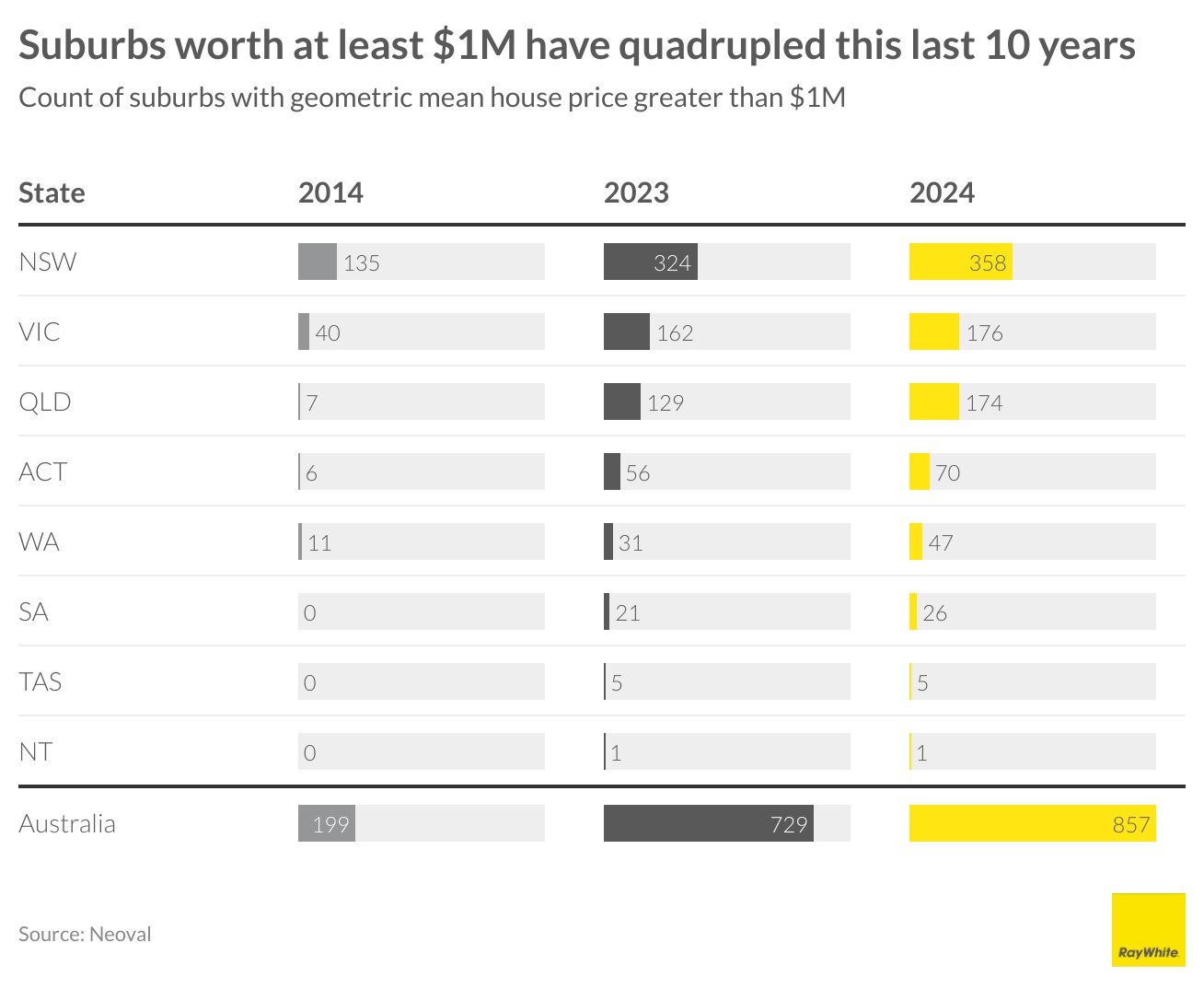Melbourne goes backwards, Perth prices rise $1,000 a day for a year
Australian property prices have “found their groove” in rising by between 0.5 and 0.8 per cent since February, with June delivering another 0.7 per cent increment.
Australian property prices have “found their groove” in rising by between 0.5 and 0.8 per cent since February, with June delivering another 0.7 per cent increment.
The year’s strong property price growth has also translated into the number of new million dollar median suburbs leaping by 17.5 per cent.
Data released Monday (1 July) by Ray White Group also showed that this benchmark median property price had quadrupled to 857 suburbs since 2014.
The current real estate market strength is largely attributed to the mid-sized capitals of Perth, Adelaide and Brisbane, which have again dominated the capital growth stakes.
CoreLogic’s Research Director Tim Lawless said the market was defying a range of potentially suppressive factors.
“The national index has found a groove, with persistent growth coming despite an array of downside risks, including high rates, cost of living pressures, affordability challenges and tight credit policy.
“The housing market resilience comes back to tight supply levels, which are keeping upwards pressure on values.”
A shortage of homes for sale is overwhelming those variables.
The growth trends are reflected in advertised stock levels.
Over the four weeks ending June, the number of homes advertised for sale in Perth were 23 per cent lower than at same time last year and 47 per cent lower than the previous five year average. Adelaide (-43 per cent) and Brisbane (-34 per cent) are also recording real estate listings that are significantly below average for this time of year.
The two-speed nature of the market’s performance is best highlighted by the gulf between Perth and Melbourne.
As these PropTrack property price heat maps show, the former is recording growth of 12 to 26 per cent around the metropolitan area, compared to Melbourne’s uniformly flatlining market locked into a tight range at or close to zero.
The Ray White House Price Report, using independent Neoval data, found Perth’s house median increased 3.6 per cent monthly and 26.7 per cent over the past year. The median has landed at $821,093, which means properties in Perth went up $985.31 a day, over a 30-day month.
Regional markets have shown a similar trend to the capitals, with regional Western Australia leading the pace of capital gains with a 1.5 per cent rise in June and 16.6 per cent increase over the financial year.
Regional South Australia and Queensland have also recorded strong growth conditions, while regional Victorian dwelling values fell by half a percent over the year and regional Tasmania recorded a mild 0.7 per cent rise
Queensland’s continued price explosion has led to first home buyers abandoning hopes of home ownership.
Antonia Mercorella, CEO, Real Estate Institute of Queensland, said the state has the lowest proportion of first home buyers in the country, and first home buyers make up less than one in five loans in the state.
“Relatively affordable price brackets are a magnet for owner occupiers and investors alike, and this broad popularity makes ‘bagging a bargain’ an unlikely scenario.
“Apartments have again forged ahead strongly, notably in the Greater Brisbane areas and relocation hotspots of the Gold and Sunshine Coasts, offering greater affordability, good locations and low-maintenance lifestyle compared to free-standing houses.
“The highest growth for apartments for the quarter was Logan (9.99 per cent) and similarly, Toowoomba apartments stood out in the regions (6.88 per cent) - both markets still sitting comfortably under the half-a-million sweet spot.
“In the housing market, the star performer over the quarter was Gladstone (6.59 per cent), followed by Toowoomba (6.55 per cent), Rockhampton (5.91 per cent) and Townsville (5.27 per cent) demonstrating the continued renaissance of the regions.”
More property price hikes expected
Eleanor Creagh, Senior Economist, PropTrack, said national home prices have cycled through 18 consecutive months of growth to hit a fresh peak in June despite the pace of growth slowing as winter begins.
“Although the number of homes hitting the market this year has lifted, strong population growth, tight rental markets and home equity gains continue to bolster demand,” she said.
“Meanwhile, building activity remains challenged, resulting in the chronic shortage of housing being exacerbated by a lack of new construction.
“Interest rate stability has sustained buyer and seller confidence, while the continuous rise in home prices is motivating many to overcome affordability challenges and transact with the expectation of further growth, and as a result, demand is outpacing supply, pushing prices and rents higher and offsetting the higher interest rate environment.
“From July, tax cuts will lift household incomes increasing borrowing capacities and buyers’ budgets, further supporting price growth.
Although home prices are expected to rise in the coming months, they will likely maintain a slower pace through the seasonally quieter winter period, particularly with increasing uncertainty around interest rates.”
Fitch Ratings has forecast nominal home prices to grow by 4 to 6 per cent in 2024 following likely growth of 9 per cent in 2023 from the trough in January 2023. More modest rises of 3 to 5 per cent will follow in 2025.
Analyst Timothy Groombridge said housing demand is high due to strong net migration and changes in household formation.
“Average household size has trended lower since the pandemic, leading to increased demand for housing.
“The low home listings seen in 2023 are expected to continue as homeowners are reluctant to sell due to fears of being unable to get a new mortgage assessed with high servicing buffers.
“New home construction has been decreasing as high inflation has resulted in increased building costs.
“Affordability constraints due to high home prices relative to income are expected to slow price rises in 2025.
“High interest rates for longer than our expectations may lead to home price movement below our forecast,” Mr Groombridge said.
With property prices showing little overall sign of slowing or retracting, the number of million dollar suburbs is set to rise further.
Atom Go Tian, Senior Data Analyst, Ray White Group, said of the six states and two territories, Queensland is the fastest growing with its count of $1 million suburbs growing by 25 times over the last decade from just seven to 174.
Most of these existing suburbs are in New South Wales, which has at least twice the number of million dollar suburbs as any other state at 358 suburbs as of 2024. Victoria comes in second with 176.
“Assuming the growth rate of the last decade maintains its trend for the next 12 months, we can expect around 99 new suburbs to pass the $1 million mark,” Mr Tian said.
“Thirty of these will come from New South Wales, 24 from Queensland, and 18 from Victoria, which means Queensland has a very high probability of overtaking Victoria as the state with the second most count of million dollar suburbs.”



























